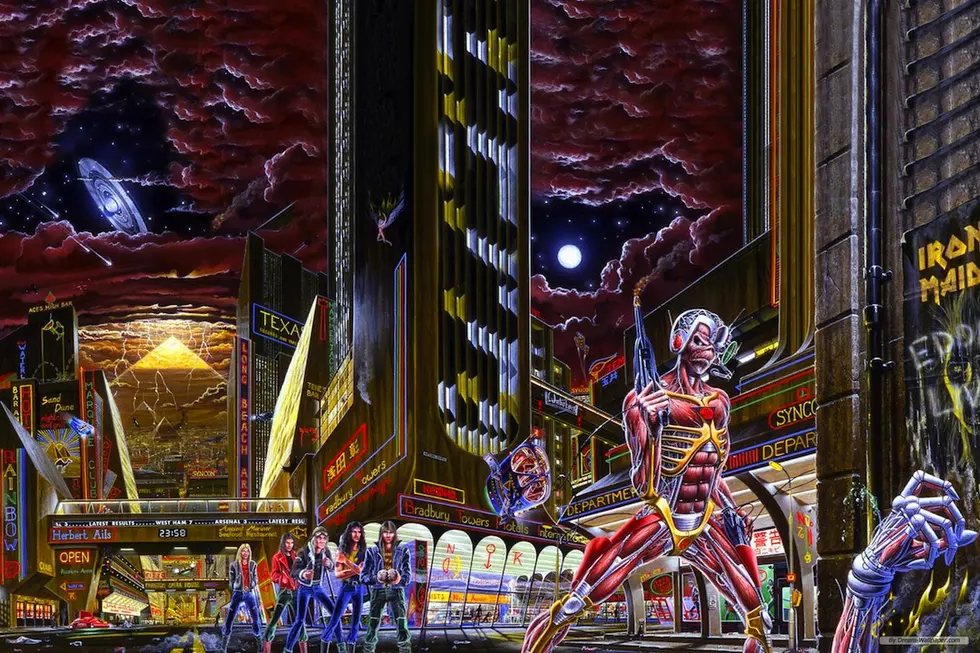
When Iron Maiden Got Futuristic With ‘Somewhere in Time’
For much of the '80s, Iron Maiden were an unstoppable metal juggernaut. Their career pretty much built album from album, counting on the support of their loyal and growing fan base. Somewhere in Time seemed no different at the time.
Maiden's sixth album arrived on Sept. 29, 1986, reaching No. 3 on the U.K. chart and giving the band its first double-platinum album in the U.S. But opinions on its merits have grown increasingly muddled over the years, to the point that it's often seen as a weak link in an otherwise victorious decade.
No such qualms assail the first five Iron Maiden albums – though, to be fair, some critics weren't entirely sold on 1981's Killers either. Somewhere in Time's predecessor, 1984's Powerslave, had signified their true arrival in the States, and taken them around the world for the record-breaking World Slavery Tour. After 11 months, there came a double live album, Live After Death, which bought the band its first real break after five years of nonstop work. Or so they thought.
"We were supposed to have six months off, which quickly became four months," singer Bruce Dickinson told Mick Wall, author of the official Iron Maiden history, Run to the Hills. "I was sitting around and I gradually started to come back to some sort of sense that ... I got into music because I wanted to tell stories [and] I thought, 'Well, what would really give me a buzz to go off and do another twelve-month tour would be if we ha another record that I really felt as groundbreaking,' you know? So I went off into 'acoustic world' and I wanted to do almost like an 'unplugged' record for the next Iron Maiden album."
Dickinson previewed three of his songs-in-progress to Wall ahead of the new album's sessions, and the author wrote in his book that he was "surprised at how folksy they were; more like something from Led Zeppelin's semi-acoustic third album." But Dickinson's bandmates rejected his submissions, and it fell to manager Rod Smallwood to break the news, as he related in Wall's book: "I always sensed a slight danger of too much input from Bruce and Adrian [Smith] because they were always in danger of kind of taking it away from what Maiden really as. Bruce has written some great songs for Maiden and we knew he'd write more. These just weren't ... right."
Watch Iron Maiden's 'Wasted Years' Video
Ultimately, Somewhere in Time's songwriting was almost evenly split between bassist and band leader Steve Harris and guitarist Smith, who'd contributed often enough in the past, but never quite like this. As things turned out, Smith gave the album its first and second singles in "Wasted Years" and "Stranger in a Strange Land," as well as fan favorite "Seas of Madness." Harris, for his part, dictated the album's momentum with the theme-setting opening title track, the stadium-sized chorus of "Heaven Can Wait," another pair of epics in "The Loneliness of the Long Distance Runner" and "Alexander the Great" and, with guitarist Dave Murray, "Deja-vu."
Together the tracks dealt with some element of space and time, but Harris told Wall this wasn't intentional. "We certainly never went in there and said, 'Right, let's write a load of songs on the subject of time.'"
Still, Smith pointed out in the same book that "if you think about what we'd just done and where we'd just been, maybe it wasn't so strange that most of the songs we seemed to come up with had something to do with time – either time wasted or time spent learning something that cost a lot. It's all there if you read between the lines."
All this tied in with illustrator Derek Riggs' futuristic painting for Somewhere in Time's cover, depicting a mechanically enhanced version of band mascot Eddie in a dystopian future inspired by Blade Runner. The technological concept also bled over into the recording itself, which found Harris trying out synthesizer backdrops while Murray and Smith wielded guitar synths, achieving a new aesthetic that modernized Iron Maiden's sound without sending it completely off the rails.
Most fans paid little mind to these gradual advancements, embracing Somewhere in Time as they had the previous Iron Maiden albums. It wasn't until a few years later, with the band's even more popular next album, Seventh Son of a Seventh Son, that more mixed emotions started to emerge about its predecessor. Even if it lacks the unanimous support enjoyed by most of the band's '80s records, however, Somewhere in Time remains an important chapter in Iron Maiden history.
Top 50 Classic Heavy Metal Albums
Iron Maiden's Rarest Songs
More From 106.3 The Buzz







![Behold the Greatest T-Rex Impression of All-Time [VIDEO]](http://townsquare.media/site/175/files/2016/09/t-rex-impression.jpg?w=980&q=75)
![Confused Deer Tries To Get Inside SUV After Accident[VIDEO]](http://townsquare.media/site/153/files/2016/09/Capture12.jpg?w=980&q=75)

